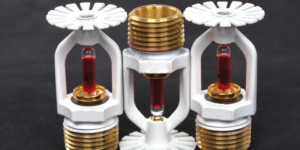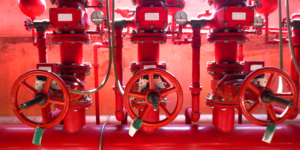Have you heard “It’s better to be safe than sorry”? This is so true for fire safety. Within minutes, fires may destroy homes and businesses and imperil lives. This is why a functional fire sprinkler system is essential.
We’ll explore fire sprinkler systems and unsung heroes that put out fires and prevent calamities. We’ll discuss their parts, types, and correct maintenance of these life-saving devices.
Frequency and Requirements
Fire sprinkler system frequency and requirements depend on numerous factors. Local code compliance is crucial. These standards govern fire sprinkler installation, maintenance, and inspections.
Many jurisdictions mandate commercial buildings to have fire sprinklers. Thus, a reliable fire suppression method is accessible. Residential buildings may have similar criteria based on local laws. Fire sprinkler systems need regular inspections to stay in top shape. Annual or semi-annual inspections verify all components for damage or malfunction. Water flow checks can also ensure the system can deliver enough water as needed.
Cleaning pipelines, repairing old parts, and checking control valves should be done routinely per manufacturer or industry standards. Maintaining your fire sprinklers regularly ensures their dependability and efficiency.
Remember that each jurisdiction may have different fire sprinkler inspection frequency and requirements. Thus, local authorities or an experienced installer/contractor should be consulted.

Introduction to Fire Sprinkler Systems
Fire sprinklers save lives and property from fires. These fire detection and control systems respond quickly to prevent more harm. Fire sprinkler systems use pipes throughout a building with sprinkler heads that release water when heat is detected. These technologies put out fires before they spread.
The control valve controls water flow in fire sprinkler systems. This outside-building valve can be manually operated or connected to an automatic detection system.
Also crucial is the alarm valve, which sounds an alarm when water flows through it. This warns residents to evacuate and emergency responders of a fire.
Sprinkler heads are the most apparent feature of a fire sprinkler system. These little devices release water straight onto heat or flames when activated by high temperatures.
Building owners and occupants must understand fire sprinkler systems and their components. Regular maintenance can improve these systems’ fire loss prevention.
The Importance of Fire Sprinkler Systems
Fire sprinkler systems are crucial to fire safety. These methods safeguard lives and property against fires. Not enough can be said about fire sprinklers. Fire detection and control systems detect and control flames before they spread. They prevent smoke and poisonous fumes from spreading and extinguish or limit fires at their source, saving lives and property.
Effective fire sprinkler systems respond fast to heat and activate automatically when temperatures reach a threshold. Many firefighting tactics require human action, however, these systems provide rapid protection even without human participation.
Any household or business property needs high-quality fire sprinkler systems. Early detection, prompt reaction, containment, and lifesaving are the benefits of these crucial components.
Components of a Fire Sprinkler System
A fire sprinkler system protects homes, companies, and other structures from fires with several critical components. These components detect and control fires early, preventing them from spreading and causing damage.
Sprinkler heads are an essential part of fire sprinkler systems. These little heat-activated devices are scattered throughout a facility. The sprinkler head sprays water to extinguish fire flames when the temperature rises.
Building sprinkler heads are connected by a piping network, another important part. This network facilitates water flow from a dedicated supply or a municipally connected system. To distribute water throughout the system, pipes must be correctly sized and installed.
Each sprinkler head has a fusible link or glass bulb filled with liquid that expands when heated to ensure correct operation. This extension releases water through that sprinkler head only, targeting fire-prone locations.
Each component is crucial to fire defense. All parts need regular inspection and maintenance to perform properly.
Types of Fire Sprinkler Systems
The correct sprinkler system is essential for fire protection. Different fire sprinkler systems are intended for different risks and conditions.
- Wet Pipe Systems: The most prevalent fire sprinkler system. Water is stored under pressure in pipes to be discharged during a fire. These devices work best in non-freezing locations.
- Dry Pipe Systems: Instead of water, dry pipe systems employ pressured air or nitrogen. They can be employed in unheated warehouses or outdoor settings where freezing temperatures are a problem.
- Pre-action Systems: Pre-action systems mix wet and dry pipe features. First, a detection system must detect heat or smoke, then the release valve opens and fills the pipes with water before discharging it through the sprinklers.
- Deluge Systems: When actuated by an alarm signal or manual operation, all sprinkler heads open simultaneously. Chemical storage facilities use high-volume systems for flammable compounds.
- Foam Water Sprinkler System: Foam water sprinkler systems use foam and water to extinguish fires caused by combustible liquids.

Maintenance and Upkeep of Fire Sprinklers
Fire sprinkler systems must be maintained to safeguard lives and property. Regular maintenance keeps these systems ready to respond swiftly to fires. Fire sprinkler systems must be maintained according to manufacturer, industry, and municipal laws. This includes regular inspections by skilled personnel who can spot system performance issues.
Fire sprinkler system maintenance includes checking for leaks or obstructions in pipes, water pressure, alarm valves, control panels, head damage or corrosion, and component functionality. These checks should be done annually or more often depending on requirements.
Along with planned inspections, repairs and replacements must be done quickly throughout the year. Inspection results and corrective actions should be recorded.
Your fire sprinkler system will operate when you need it and last longer with regular maintenance. Spending time and money on system maintenance now can avert costly issues later.
We make homes and businesses safer by prioritizing fire sprinkler maintenance. Our primary fire safety goal should always be life and property protection.
Maintenance saves lives! Contact qualified professionals today for regular checks!
